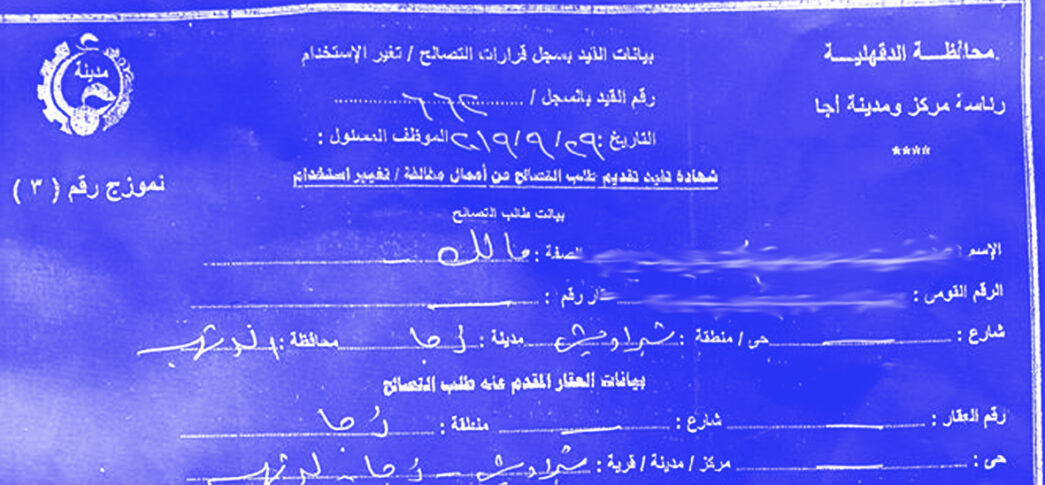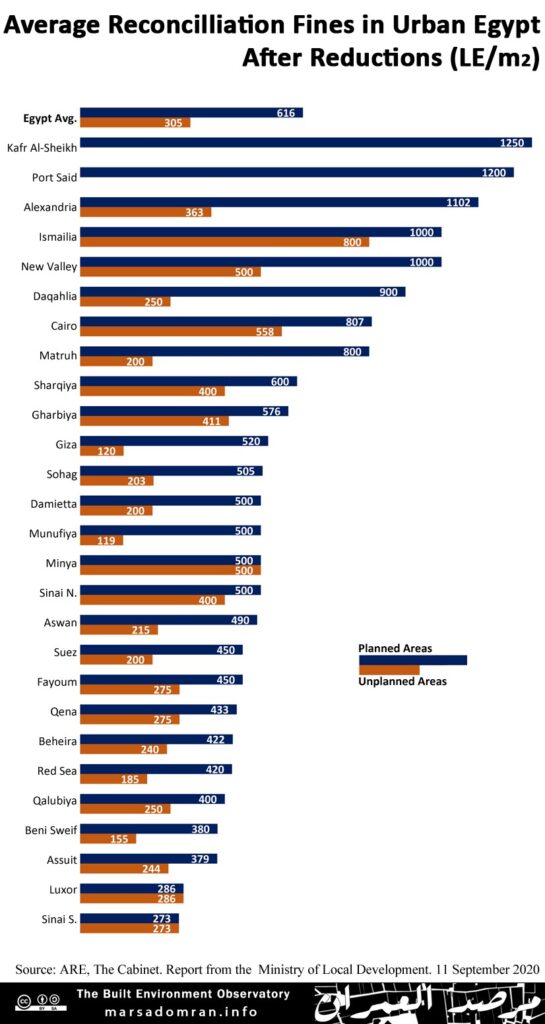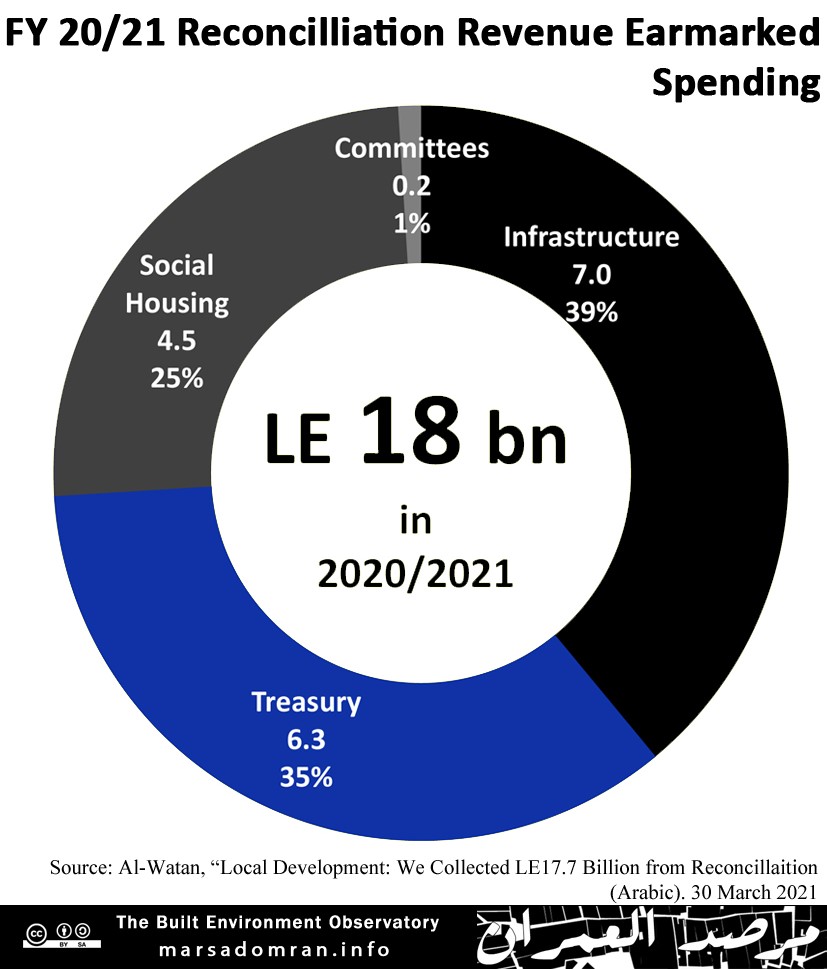
- Published on 16 April 2021
Law 1/2020[1] was passed in January 2020 to amend the unpopular Construction Violations Reconciliation Law,[2] which had resulted in only 89,199 owners applying to legalise their property by the end of its original deadline in December 2019[3]—a trivial number compared to the more than eight million units estimated to have been informally built over the last decade alone,[4] representing three quarters of all construction and thus the majority of households. The amendments sought to simplify the original process, but still suffered from bureaucratic complications and apathy from residents and owners. By the end of March 2020, the enactment of the amended bylaws,[5] extending the deadline to September 2020, coincided with the onslaught of the coronavirus pandemic and ensuing partial lockdown and evening curfew in Egypt. Shortly thereafter, the government froze construction in all major cities,[6] fearing a spike in illegal construction as the government tended to the coronavirus crisis.
For all legislation related to the Reconciliation Law, Click here
The pandemic induced widespread income loss, estimated to have affected three quarters of the workforce,[7] and the steep fines outweighed the minimal benefits of legalization; by June property owners submitted only 330,000 applications.[8] The government responded by imposing an immediate 25% down-payment towards the fine for all current and future applications[9] and began the unprecedented demolition of illegal construction built after the reconciliation law came into force in April 2019 (and hence do not benefit from reconciliation).[10] These measures increased property owners’ compliance with the law, but it also increased resistance. As significant income loss accumulated and calls for protest increased in September 2020,[11] the government cut fines by between 30% and 70% in urban areas (Fig. 1) [12] and brought them down to the minimum of LE50 per square meter in all rural areas just weeks before the deadline.[13] Prime Minster Mustafa Madbouly also promised that occupied dwellings would not be demolished,[14] and extended the September deadline four times; the last reconciliation deadline was the end of March 2021.[15]
Figure 1

Impact
These concessions resulted in applications reaching 2.9mn by the end of the final deadline at the end of March 2021.[16] These applications may represent anywhere between three to nine million units, as one application could include multiple units. Furthermore, the government will not accept all applications as the law prohibits the reconciliation of some violations. For those applications that it did accept, full legalisation would only occur once owners pay the full fine—not be before 2024 at the earliest for most assuming that owners pay the remaining yearly instalments. Only then and only with the statistics disaggregated by the number of units under consideration (not simply whole buildings) assess percentage of homes formally recognized by the law. Overall, there seems to be a significant number of properties that will not be formalized, leading Parliament’s Local Development Committee to discuss plans for how to deal with them. Committee head MP Ahmed al-Sagini put forward the paradox the state is in,[17] having to balance out between upholding the law by demolishing unformalized buildings, and the social and security ramifications this may have, stating that the law may need to be modified to accommodate this stalemate. This may signal that this is far from a closed case, and a new round of reconciliation with a new set of rules and fines may be enacted in the near future.
In terms of revenue collection, parliamentarians estimated that the law would bring in LE 100bn[18] to LE 700bn.[19] However, the amount collected by the end of implementation was closer to LE 18bn and projected to be LE 70-75bn,[20] considering that a further 75% of the fine will be collected in instalments over the next three years. However, this fine has contributed towards 13% of spending on urban development projects in the current financial year, where a majority of revenue is earmarked for (Fig. 2). In the end, this is a one-off fine that only acts as an exceptional boost to the treasury, and is not renewable.
Figure 2

[1] ‘Law 1/2020’, Amending Construction Violations Reconciliation Law 17/2019 § (2020), https://web.archive.org/web/20201216141601/https://www.cc.gov.eg/legislation_single?id=394244
[2] ‘Law 17/2019’, Construction Violations Reconciliation § (2019), 20, https://web.archive.org/web/20201216141603/https://www.cc.gov.eg/legislation_single?id=391179
[3] Al-Ahram, ‘Maglis Al-Muhafzin Bi-Ri’asat Madbouli Yutabi’a Igra’at Tanfiz Qanun al-Tasaluh Fi Mukhalafat al-Bina’’, 15 December 2019, http://gate.ahram.org.eg/News/2334031.aspx
[4] Built Environment Observatory, ‘Who Builds Egypt’s Housing? Construction Facts by Sector 2008 > 2018’, 4 November 2019, http://marsadomran.info/en/facts_budgets/2019/11/1837/
[5] ‘Prime Ministerial Decree 800/2020’, Amending Reconciliation Law bylaws § (2020), https://www.cc.gov.eg/i/l/404182.pdf
[6] ‘Minister of Local Administration Decree 181/2020’ (2020), https://www.diigo.com/item/image/2r7n0/ij81
[7] CAPMAS, ‘The Effects of the Coronavirus on Egyptian Households until May 2020 (Arabic)’ (Cairo: Central Agency for Public Mobilization and Statistics (CAPMAS), June 2020), 5, https://www.capmas.gov.eg/Pages/StaticPages.aspx?page_id=7233
[8] Al-mal, ‘al-tanmiya al-mahaliya tatalaqa 330 alf talab li-l-tasaluh fi mukhalfat al-bina’’, 12 June 2020, https://archive.vn/wip/tPzqu
[9] ‘Minister of Local Administration Circular 199/2020’, In relation to the Reconciliation Law and regulating the building procedure in Egypt § (2020), https://www.diigo.com/item/image/2r7n0/91i4
[10] Ahram Online, ‘Egypt’s Sisi Says Will Deploy Army to Remove Illegal Buildings Built on Agricultural Land If Problem Persists – Politics – Egypt’, 29 August 2020, http://english.ahram.org.eg/NewsContent/1/64/378853/Egypt/Politics-/Egypt%E2%80%99s-Sisi-says-will-deploy-army-to-remove-illeg.aspx
[11] Ruth Michaelson, ‘Threat of Home Demolitions Sparks Protests among Egypt’s Poorest’, The Guardian, 6 October 2020, http://www.theguardian.com/world/2020/oct/06/egypt-security-forces-target-rare-anti-government-protests
[12] ARE, The Cabinet, ‘Taqrir Min Wazir Al-Tanmiya al-Mahaliya’, 11 September 2020, https://archive.is/HbU0N
[13] Al-Ahram, ‘Madbouli: Al-Ra’ies al-Sisi Waggah Bi Tahdid Qimat al-Tasaluh Li-Kul al-Rif al-Masri 50 Junayhan Li-l-Mitr’, 12 September 2020, http://gate.ahram.org.eg/News/2460524.aspx
[14] ARE, The Cabinet, ‘Tasrihat Telefizioniya Li-Ra’ies Majlis al-Wuzara’’, 24 September 2020, https://archive.is/2ljZ9
[15] Built Environment Observatory, ‘A Collection of Legsilation and Official Documents Related to the Reconciliation Law (Arabic)’, 3 January 2020, http://marsadomran.info/facts_budgets/2020/01/1873/
[16] Al-Ahram, ‘Majlis Al-Wuzara’: 2.9 Milion Talab Tam Taqadimaha Li-l-Tasaluh Fi Mukhalfat al-Bina’’, accessed 9 April 2021, https://gate.ahram.org.eg/News/2684548.aspx
[17] Al-Youm al-Sabe‘, ‘Al-Tasaluh Fi Mukhalfat al-Bina’ ’ala Tawlat Mahaliyat al-Nuwab’, 7 April 2021, https://archive.is/3vwzR
[18] Al-Borsa, ‘Na’ib: Al-Hukuma Ta’ahadat Amam al-Parlaman Bi Tahsil 100 Milyar Junayh Fi Malaf al-Tasaluh Li-Mukhalafat al-Bina’’, 7 September 2020, https://alborsaanews.com/2020/09/07/1380429
[19] Al-Mal, ‘Bayan ’ajil fi-l-parlaman bi sabab ihdar muwazafi al-mahaliyat 700 milyar junayh ’ala al-dawla’, 12 June 2020, https://archive.is/PGfO0
[20] Al-Watan, ‘Al-tanmiya al-mahaliya: hasalan 17.7 milyar junayh qimat tasaluh’, 30 March 2021, https://www.elwatannews.com/news/details/5407133
